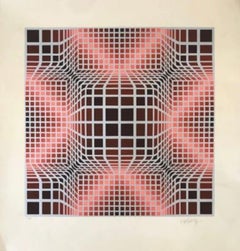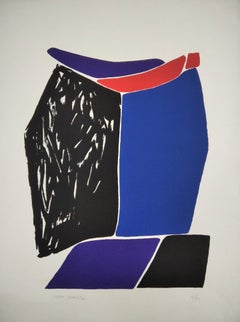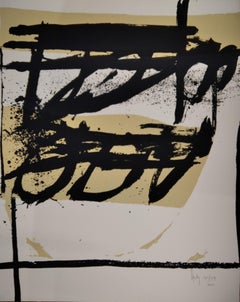(After) Victor Vasarely Abstract Paintings
1906-1997
Considered the father of the Op Art, artist Victor Vasarely was born on April 9th, 1908 in Pécs, Hungary. Internationally recognized as one of the most important artists of the 20th century, his innovations in color and optical illusion have had a strong influence on many modern artists. Spanning most of his career, our collection of his prints and sculptures explores his forays into some of his most famous works such as the plastic alphabet and other iconic periods.to
1
Overall Width
to
Overall Height
to
1
1
1
1
43
664
614
464
342
Artist: (After) Victor Vasarely
Untitled
By (After) Victor Vasarely
Located in PARIS, FR
Victor Vasarely was a Hungarian-born French Op Art painter. He was best known as the "grandfather" of the Op Art movement of the 1960s. Vasarely was born in 1908 in Pecs, Hungary. He...
Category
1980s (After) Victor Vasarely Abstract Paintings
Materials
Lithograph
Related Items
No title
Located in Barcelona, BARCELONA
Includes a Certificate of Authenticity
Category
1990s Abstract Geometric (After) Victor Vasarely Abstract Paintings
Materials
Lithograph
Untitled
Located in Barcelona, BARCELONA
original and certificated by the gallery
Category
Early 2000s Abstract (After) Victor Vasarely Abstract Paintings
Materials
Lithograph
Target acrylic on paper geometric Color Field painting signed & inscribed Framed
By Kenneth Noland
Located in New York, NY
Kenneth Noland
Untitled Target, 2001
Acrylic paint on offset lithograph paper
Signed, dated, and dedicated along lower edge: For Howard and Susan with Love Kenneth Noland 6.10.01
Fra...
Category
1990s Color-Field (After) Victor Vasarely Abstract Paintings
Materials
Acrylic, Permanent Marker, Lithograph, Offset
Kenneth NolandTarget acrylic on paper geometric Color Field painting signed & inscribed Framed, 2001
$28,000
H 22 in W 21.75 in D 1.25 in
Untitled
Located in Barcelona, BARCELONA
The painting is being offered with a work and authenticity certificate
Category
1990s Conceptual (After) Victor Vasarely Abstract Paintings
Materials
Lithograph
Untitled
Located in Barcelona, BARCELONA
The painting is being offered with a work and authenticity certificate
Category
1970s Abstract (After) Victor Vasarely Abstract Paintings
Materials
Lithograph
"Abstract"
By Alexander Liberman
Located in New Orleans, LA
Alexander Liberman (Ukrainian/American 1912-19990 Colored lithograph, signed in the lower right and dated '75 in pencil, numbered in the lower left, and presented in a chrome frame.
...
Category
1970s (After) Victor Vasarely Abstract Paintings
Materials
Lithograph
Pop Art Brut Collage Mixed Media Print, Painting, Burning, Tape, Marty Greenbaum
Located in Surfside, FL
Marty Greenbaum (1934-2020)
''Brooklyn Local in Wisconsin''
Lithograph, with hand-coloring, blind stitching, stitching, burning, tape collage and paint
with Jewish, Hasidic, Sleepy Moishy character.
Marty Greenbaum (1934-2020) was an American painter, mixed media assemblage and book artist.
Greenbaum is best known for his mixed media assemblage, painting and artist books. Greenbaum appeared in three films: Hallelujah the Hills in 1963 by Adolfas Mekas, Life Dances On, in 1980 by Robert Frank, and The Present in 1996 by Robert Frank. Between 1962 and 1965 he took part in happenings by Allan Kaprow and experimental dance by Yvonne Rainer. Greenbaum authored his own happenings, i.e. Coney Island Carny, including artists such as Eddie Barton, Remy Charlip, Paul Kaplow, Paul Krasner, Al Hanson, Ed Blair, Allen Ginsberg, John Hammond, Eddie Rabkin, Lou Gossett, Renee Renee, Allan Kaprow, Phyllis Yampolsky, Thomas Hoving, Jackie Ferrara, Peter Schumann, Jim Bell, Bill Marshall, Corla Lopez, Bruce Waite, and Mark di Suvero, as well as organizing the Hall of Issues with Phyllis Yampolsky at The Judson Memorial Church.
Greenbaum had several teaching positions in the New York City public school system and was a member of the Creative Artists Public Service program twice, he also participated in various exhibitions with book objects. His work is in several public collections including The Art Institute of Chicago, Artists' Books, The Brooklyn Museum Collection, The Chrysler Museum, Norfolk, VA, Citibank, NYC, Colgate University, Hamilton, NY, Jacksonville Art Museum, Jacksonville, FL, Madison Art Center, Madison, WI, SUNY at New Paltz, NY and more.
Books as Objects
"Greenbaum, an early conceptualist, burned books in the 1960s, exhibiting the remains as 'corpses.' Today, he makes fetishistic notebooks filled with colored paper and scribbled equations, accretions of feathers and Rhoplex."
"Marty Greenbaum and Barton Lidice Benes destroy texts to create sculpture: Benes 'Bound Book,' a literal rope and wax imprisonment, and Greenbaum's 'Cutting Up,' a mixed media paste over of muted colors." Some of his most notable artist books include: "Batman" 1963-67, "In '84 Returned in 2004". Two stories about Marty from James Pernotto: we met at William Weege print shop in 1974 when he drove out from NYC with Alan Shields and Paco Grande and I was a lithography printer hired to work with them. Alan recalled on the trip out that Marty was working on his altered books and putting airplane glue on the pages and lighting it with a match. Enough said. I printed for Marty.
Solo exhibitions
2007 Two Artists, Windsor Whip Works, Windsor NY
2001 Pacifico Fine Art, NYC
1972, 1979, 1985 Allan Stone Gallery, NYC
1977 Picker Art Gallery, Colgate University, Hamilton NY
1963, 1964, 1965 Stryke Gallery, NYC
Group and Traveling exhibitions
2019 One Plus One Equals Three, curated by Roger Winter, Kirk Hopper Fine Art, Dallas, TX
Collage and assemblage by Romare Bearden, Roy Fridge, Marty Greenbaum, David McManaway, Robin Ragin, Nancy Willis Smith, and Roger Winter.
2017 Sorcery & Craft, Allan Stone Projects, New York, NY
2008 8 Artists 8 Books, 5 + 5 Gallery, Brooklyn, NY
1999 Talent, Allan Stone Gallery, New York, NY
1998 Artist Books, Bound & Unbound Gallery, New York, NY
1992 Fetishism, Allan Stone Gallery, New York, NY
Salon of the Book, Caroline Corre, Paris, France; Artists; Books, Centre Georges Pompidou, Paris, France
1979 "Book Makers: Center for Book Arts First Five Years", Arthur A. Houghton, Jr. Gallery, The Cooper Union, NYC
1978 The Detective Show MoMA, PS1, Queens, NY (with Richard Artschwager and Gordon Matta Clark...
Category
1970s Arte Povera (After) Victor Vasarely Abstract Paintings
Materials
Paint, Tape, Mixed Media, Lithograph
LARRY RIVERS (hand signed and inscribed first edition book)
By Larry Rivers
Located in New York, NY
Larry Rivers
LARRY RIVERS (hand signed and inscribed first edition book), 1989
Hardback monograph with a dust jacket (hand signed and inscribed "Enjoy the Matisse"
Signed, dated and inscribed by Larry Rivers in red marker on the title page
11 3/5 × 9 4/5 inches
Lavishly illustrated hardback monograph with dust jacket on the occasion of the artist's career retrospective. Text is by the distinguished art historian and Princeton professor Sam Hunter.
Hand signed, dated and dedicated in red marker on the title page.
Inscription reads:
To Joanne and Ira
Enjoy the Matisse
Larry Rivers, April 2, 1992
About the book:
Hunter, Sam. LARRY RIVERS. 358 pp. with 400 illustrations, including 155 plates in color. Folio, cloth. New York, Rizzoli, 1989.
New York: Rizzoli, 1989. First edition. Hardcover. 358 pages. Retrospective monograph on Larry Rivers. Features text by Sam Hunter. Includes 400 illustrations of which 155 are in color.
Publisher's Blurb:
Rivers' public persona as an artist combines that of bohemian outsider, sensualist and entertainer. His best-known images of the 1960s--Dutch Masters cigars, French money, cigarette packs--became Pop icons. Eschewing abstraction, he came up with startling, disquieting figures, such as his obese, sagging mother-in-law depicted in the nude with brutal honesty ( Double Portrait of Berdie ). Yet there is more to Rivers than the hipster, as this lavishly illustrated monograph by a former Princeton art historian shows. Hunter makes a case for Rivers as a social realist: witness his powerful construction piece Ghetto Stoop or recent works that include searching portraits of Primo Levi...
Category
1980s Pop Art (After) Victor Vasarely Abstract Paintings
Materials
Mixed Media, Permanent Marker, Lithograph, Offset
Costa catalana
Located in Barcelona, BARCELONA
Includes a Certificate of Authenticity
Category
1980s Abstract (After) Victor Vasarely Abstract Paintings
Materials
Lithograph
Untitled
Located in Barcelona, BARCELONA
Includes a Certificate of Authenticity
Category
1990s Contemporary (After) Victor Vasarely Abstract Paintings
Materials
Lithograph
Untitled
By Bengt Lindström
Located in Barcelona, BARCELONA
The painting is being offered with a work and authenticity certificate
Category
1980s Abstract (After) Victor Vasarely Abstract Paintings
Materials
Lithograph
Large Abstract Expressionist Figure Handmade Paper Etching Silkscreen Print
By Sam Messer
Located in Surfside, FL
This is done on a very interesting handmade paper (Japanese?) it is hand signed and numbered.
In this print the artist Sam Messer uses bold contrasting colors in a gestural manner. Messer's work, so apparently spontaneous or impulsive in its emphasis on highly dramatic gestural brushstrokes and intense color, is, in fact, carefully considered. The treatment of the composition conveys dynamic movement through the sweep...
Category
1980s Abstract Expressionist (After) Victor Vasarely Abstract Paintings
Materials
Handmade Paper, Lithograph, Screen
$1,500
H 36.5 in W 24 in
(after) Victor Vasarely abstract paintings for sale on 1stDibs.
Find a wide variety of authentic (After) Victor Vasarely abstract paintings available for sale on 1stDibs. You can also browse by medium to find art by (After) Victor Vasarely in lithograph and more. Not every interior allows for large (After) Victor Vasarely abstract paintings, so small editions measuring 25 inches across are available. (After) Victor Vasarely abstract paintings prices can differ depending upon medium, time period and other attributes. On 1stDibs, the price for these items starts at $7,733 and tops out at $7,733, while the average work can sell for $7,733.
Questions About (After) Victor Vasarely Abstract Paintings
- Who is Victor Vasarely?1 Answer1stDibs ExpertMarch 22, 2022Victor Vasarely was a Hungarian-French artist best known for his Op art. By combining principles of geometry with artistic techniques, he produced two-dimensional works with incredible depth. Some even seem to move on the canvas. Vasarely also made sculptures, collages and decorative accents. On 1stDibs, shop a variety of Victor Vasarely art.
- Where is Victor Vasarely from?1 Answer1stDibs ExpertMarch 22, 2022Victor Vasarely was originally from Hungary. He was born in Pécs on April 9, 1906. His family moved to Piešťany, Slovakia, during his childhood, and he attended medical and art schools in Budapest, Hungary. In 1930, Vasarely relocated to Paris, France, and lived there until his death on March 15, 1997. On 1stDibs, find a variety of Victor Vasarely art.
- 1stDibs ExpertMarch 22, 2022To pronounce Victor Vasarely, say "VIK-tr va-sr-EH-lee." His first name and surname are Hungarian. The artist, known as one of the pioneers of Op art, was born in Pécs, Hungary, on April 9, 1906. Find a variety of Victor Vasarely art on 1stDibs.
- When was Victor Vasarely born?1 Answer1stDibs ExpertMarch 22, 2022Victor Vasarely was born in Pécs, Hungary, on April 9, 1906. Over the course of his life, he lived in Piešťany, Slovakia; Budapest, Hungary; and Paris, France. He died in Paris on March 15, 1997. On 1stDibs, find a selection of Victor Vasarely art.
- 1stDibs ExpertApril 5, 2022Victor Vasarely's famous painting Zebra is on display at the Pompidou Centre in Paris, France. He painted the piece in 1937. You can see elements of the Op art style that Vasarely would later become famous for taking shape in the painting. On 1stDibs, find a range of Victor Vasarely art.
- What inspired Victor Vasarely?1 Answer1stDibs ExpertMarch 22, 2022Many things inspired Victor Vasarely over the course of his life. The color theory of Josef Albers, and the Constructivist methods of Wassily Kandinsky greatly influenced his work. He also found inspiration in the geometry of the natural world, particularly in the landscapes of Breton Beach of Belle Isle in France. On 1stDibs, find a selection of Victor Vasarely art.
- 1stDibs ExpertFebruary 13, 2024One key fact about Victor Vasarely is that he is considered the grandfather of Op art due to his eye-popping geometric abstractions that play with the viewer’s perception of depth, perspective and motion. He was born in Pécs, Austria-Hungary, on April 9, 1906, and began studying medicine at the Eötvös Loránd University in 1925 with the hope of one day becoming a doctor. Two years later, he shifted gears and enrolled in a painting course at the Podolini-Volkmann Academy. In the 1960s, he developed an alphabet plastique, or fine art alphabet, consisting of elementary visual building blocks that could be used in endless combinations to create original compositions. One final fact is that both Hungary and France have issued postage stamps featuring his artwork. On 1stDibs, explore a range of Victor Vasarely art.
- 1stDibs ExpertApril 22, 2024Here are some facts about Victor Vasarely's art. First, his work contributed to the development of Op art and consisted largely of eye-popping geometric abstractions that play with the viewer's perception of depth, perspective and motion. A classic example is the 1937 Zebra, which consists of undulating black and white stripes that suggest the form of the titular animal through optical trickery. The work is often credited as the earliest Op art painting. Vasarely wasn't just attempting to fool the eye; he wanted to "democratize" art by producing work in large editions at reasonable prices and with themes that were understandable across national and cultural boundaries. Also, Vasarely developed an alphabet plastique, or fine art alphabet, consisting of elementary visual building blocks that could be used in endless combinations to create original compositions. By employing this universal visual vocabulary and stripping away topical references, he sought to create what he called a "Planetary Folklore." On 1stDibs, shop a selection of Victor Vasarely art.
- 1stDibs ExpertApril 5, 2022Victor Vasarely was an artist, working in painting, sculptures and collages. His vibrant, geometric pieces earned him the nickname of ‘grandfather’ of the Op Art movement. Shop a selection of Victor Vasarely’s pieces from some of the world’s top art dealers on 1stDibs.
- 1stDibs ExpertFebruary 1, 2024Victor Vasarely is best known for producing sculptures and paintings with a grid-like appearance. The Hungarian-French artist first began to create these works in 1960, aiming to play with how viewers perceive depth and form. These works demonstrated that kinetic art could be two-dimensional and evoke a sense of movement despite remaining stationary. On 1stDibs, find a selection of Victor Vasarely art.
- 1stDibs ExpertFebruary 21, 2024The name of one of the most well-known artworks by Victor Vasarely is Zebra. He produced the piece in 1937, and it depicts two zebras with bold black stripes that seem to undulate before the eye. Other acclaimed works by the Hungarian-French artist include Vega-Nor, Tekers MC, Keple-Gestalt, The Chess Board, Vonal-Stri, Vega 200 and Orion Gris. Explore a collection of Victor Vasarely art on 1stDibs.
- 1stDibs ExpertMarch 22, 2022Victor Vasarely used a variety of materials to produce his art. He painted with both oils and acrylics and usually used canvas as the base of his works. Many of his sculptures feature lucite and glass. On 1stDibs, find a collection of Victor Vasarely art.
- 1stDibs ExpertMarch 22, 2022Many historians identify Zebras as Victor Vasarely's most famous piece. He painted the work in 1937. Some of his most famous Op art compositions include Tridim, Vega-Nor, Denfert and Cheyt-M. On 1stDibs, find a range of Victor Vasarely art.
- 1stDibs ExpertMarch 22, 2022Yes, Victor Vasarely was an abstract artist. Specifically, he was a part of the Op art movement, which focused on depicting two-dimensional abstract images that appear three-dimensional. His best known works include Zebras, Tridim, Vega-Nor, Denfert and Cheyt-M. Find a collection of Victor Vasarely art on 1stDibs.
- 1stDibs ExpertApril 5, 2024How Victor Vasarely created his art varied. For his paintings, the Op artist typically used canvas as a base, painstakingly adding geometric forms in oil and acrylic paint. When producing sculptures, Vasarely often used lucite and glass to give his works a feeling of depth and luminosity. On 1stDibs, find a variety of Victor Vasarely art.
- 1stDibs ExpertMarch 22, 2022Victor Vasarely produced Op art by employing principles of physics and geometry. He painted his works by hand with oils and acrylics on canvas in a way that made the images seem three-dimensional and capable of movement. On 1stDibs, shop a selection of Victor Vasarely art.
- 1stDibs ExpertMarch 22, 2022The exact number of paintings Victor Vasarely painted is unknown. However, historians know of more than 1,000 works produced by the artist over the course of his life. In addition to paintings, he produced sculptures, collages and decorative objects. On 1stDibs, shop a range of Victor Vasarely art.
- 1stDibs ExpertMarch 13, 2024There are many examples of Op art by Victor Vasarely, who is widely considered the grandfather of this art movement. A classic example is 1937’s Zebra, which has undulating black and white stripes that suggest the form of the titular animal through optical trickery. The work is often credited as the earliest Op art painting. Other Op art works by Vasarely include Vega-Nor, The Chess Board, Vonal-Stri and Keple-Gestalt. Shop a range of Victor Vasarely art on 1stDibs.
- 1stDibs ExpertMarch 22, 2022The exact number of artworks produced by Victor Vasarely is unknown. However, references include more than 1,000 pieces attributed to the Hungarian-French artist. Vasarely shaped the Op art movement with pieces like Tridim, Vega-Noir and Cheyt-M. On 1stDibs, shop a selection of Victor Vasarely art.
- 1stDibs ExpertApril 5, 2022Victor Vasarely made 44 works of art in his lifetime. The artist’s paintings fell into the Op-Art movement and his work entitled Zebra is considered one of the earliest examples of Op-Art. His paintings often focus on bold colors, shading, shapes and optical illusions. Shop a selection of Vasarely pieces from some of the world’s top art dealers on 1stDibs.


